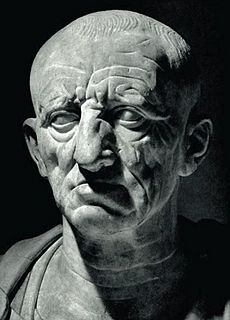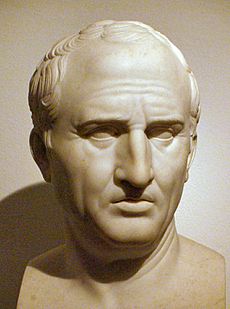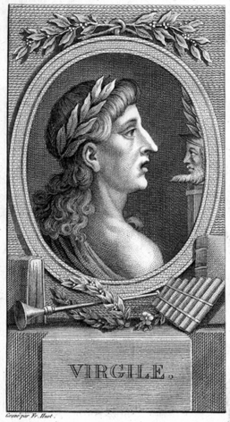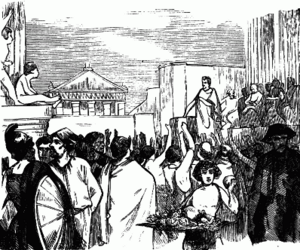Latin literature facts for kids
Latin literature includes all the essays, histories, poems, and plays written in the Latin language. It officially began in 240 BC, when the first stage play in Latin was performed in Rome. Latin literature then grew and thrived for the next six centuries. The main periods of classical Latin literature are: Early Latin literature, the Golden Age, the Imperial Period, and Late Antiquity.
Latin was the language of the ancient Romans. It was also the main language used for communication in Western and Central Europe throughout the Middle Ages. Latin literature includes works by famous Roman authors like Cicero, Virgil, Ovid, and Horace. It also includes writings by European authors after the Roman Empire ended, such as religious writers like Aquinas (1225–1274) and thinkers like Francis Bacon (1561–1626) and Isaac Newton (1642–1727).
Contents
History of Latin Writing
How Latin Literature Began
Formal Latin literature started in 240 BC. This was one year after the First Punic War ended. At this time, comedies and tragedies began to be performed regularly in Rome.
These first plays were adapted from Greek plays by Livius Andronicus. He was a Greek prisoner of war brought to Rome in 272 BC. Andronicus translated Homer's Odyssey into Latin. He used a traditional Latin poetry style called Saturnian meter.
In 235 BC, Gnaeus Naevius, a Roman citizen, continued this tradition. He created plays that were based on Greek originals, called fabula palliata. He also started a new type of play called fabula praetexta in 222 BC. These were tragedies based on Roman myths and history. Later, Naevius wrote an epic poem about the First Punic War, a war he had fought in.
Other epic poets followed Naevius. Quintus Ennius wrote a historical epic called the Annals around 200 BC. It described Roman history from the founding of Rome up to his own time. Ennius started using Greek dactylic hexameter, which became the standard style for Roman epic poems. He was also famous for his tragic plays.
The most famous writers of early Latin comedy were Plautus and Terence. We still have 26 of their comedies today. Plautus wrote 20 of them, and Terence wrote six. These writers based their comedies on Greek plays called New Comedy. However, they freely changed the plots and words. Plautus added songs to his plays and made them funnier with jokes and funny actions. Terence's plays were more polite and focused on everyday family situations. His works later inspired French and English comedies in the 1600s.

The best-known prose (non-poetry) writing from this time is On Agriculture (160 BC) by Cato the Elder. Cato wrote the first Latin history of Rome and other Italian cities. He was also the first Roman leader to write down his political speeches. He did this to influence public opinion.
Early Latin literature ended with Gaius Lucilius. He created a new kind of poetry in his 30 books of Satires (2nd century BC). He wrote in a relaxed, conversational style about books, food, friends, and current events.
The Golden Age of Latin Writing
This period is traditionally seen as the peak of Latin literature. It lasted from 81 BC to AD 17. It is said to have started with the first known speech by Cicero and ended with the death of Ovid.
The Time of Cicero

Cicero is known as the master of Latin prose (non-poetry writing). He wrote from about 80 BC until his death in 43 BC. His writings are vast and cover many topics. They are also known for their excellent style.
Cicero's many works can be divided into four groups:
- Letters: These give detailed information about an important time in Roman history. They also show a clear picture of public and private life among the Roman ruling class.
- Rhetorical writings: These works on public speaking are our most valuable Latin sources for ancient ideas about education and rhetoric (the art of speaking well).
- Philosophical works: His writings on philosophy were the basis for moral philosophy during the Middle Ages.
- Speeches: His speeches inspired many European political leaders and the people who founded the United States.
Julius Caesar and Sallust were excellent historical writers during Cicero's time. Caesar wrote about the Gallic and civil wars. He used a simple style to explain why he acted as he did as a general. He also described people and their reasons for acting.
Lyric poetry (poetry that expresses emotions) also began in Latin during this period. The poems of Catullus are known for their strong emotions. Around the same time, Lucretius explained the Epicurean philosophy in a long poem called De rerum natura.
One of the most knowledgeable writers of this period was Marcus Terentius Varro. He wrote about many different subjects, from religion to poetry. However, only his writings on agriculture and the Latin language are still complete today.
The Augustan Age

Emperor Augustus was very interested in the literary works created during his rule (27 BC to AD 14). This time is sometimes called the Augustan Age of Latin Literature.
Virgil published his pastoral poems Eclogues, the Georgics, and the Aeneid. The Aeneid is an epic poem that tells the story leading to the creation of Rome. Virgil explained how the Trojan hero Aeneas became the ancestor of the Roman people. He also showed how the gods supported Roman rule over the world. Even though Virgil died before finishing his poem, it was soon seen as the greatest work of Latin literature.
Virgil's friend Horace wrote Epodes, Odes, Satires, and Epistles. The Odes are perfect in their content, form, and style. They have delighted readers for hundreds of years. The Satires and Epistles discuss ethical and literary problems in a clever and polite way. Horace's Art of Poetry explained the basic rules of classical writing as the Romans understood them. After Virgil died, Horace became Rome's leading poet.
Latin elegy (a type of sad or thoughtful poem) reached its best in the works of Tibullus, Propertius, and Ovid. Most of this poetry is about love. Ovid also wrote the Fasti, which describes Roman festivals and their legendary origins. Ovid's greatest work, the Metamorphoses, combines various myths into a fast-paced, exciting story. Ovid was a witty writer who was excellent at creating lively and passionate characters. The Metamorphoses was the most famous source of Greek and Roman mythology throughout the Middle Ages and the Renaissance. It inspired many poets, painters, and composers.
In prose, Livy wrote a history of the Roman people in 142 books. Only 35 of these books have survived, but they are a major source of information about Rome.
The Imperial Period of Latin Writing
From the death of Augustus in AD 14 until about AD 200, Roman authors focused on style. They tried new and surprising ways of expressing themselves.
During the rule of Nero (AD 54 to 68), the philosopher Seneca wrote many dialogues and letters. These were about moral topics like mercy and generosity. In his Natural Questions, Seneca studied earthquakes, floods, and storms. Seneca's tragedies greatly influenced the growth of tragic plays in Europe. His nephew Lucan wrote the Pharsalia (around AD 60). This was an epic poem about the civil war between Caesar and Pompey.
The Satyricon (around AD 60) by Petronius was the first picaresque Latin novel. A picaresque novel tells the adventures of a clever, often low-class, hero. Only parts of the complete work survive. It describes the adventures of various low-class characters in strange, over-the-top, and dangerous situations, often involving small crimes.
Epic poems from this time include the Argonautica by Gaius Valerius Flaccus. It tells the story of Jason and the Argonauts searching for the Golden Fleece. There was also the Thebaid by Statius, about the conflict between Oedipus's sons. The Punica by Silius Italicus tells the story of the Second Punic War and Hannibal's invasions of Italy.
The epigram (a short, witty, often satirical poem) became very sharp and biting in the hands of Martial. Juvenal wrote satires (works that make fun of human weaknesses) about bad behavior.
The historian Tacitus painted a dark picture of the early Roman Empire in his Histories and Annals. Both were written in the early 2nd century. His contemporary Suetonius wrote biographies of the 12 Roman rulers from Julius Caesar to Domitian. The letters of Pliny the Younger described Roman life of the period. Quintilian wrote the most complete work we have on ancient education.
Important works from the 2nd century include the Attic Nights by Aulus Gellius. This is a collection of stories and reports of literary discussions among his friends. There are also the letters of the speaker Marcus Cornelius Fronto to Marcus Aurelius. The most famous work of the period was Metamorphoses, also called The Golden Ass, by Apuleius. This novel is about a young man who accidentally turns into a donkey. The story is full of tales of love and witchcraft.
Latin in Later Times
Pagan (non-Christian) Latin literature had a final burst of energy from the late 200s to the 400s AD. Key writers included Ammianus Marcellinus in history, Quintus Aurelius Symmachus in public speaking, and Ausonius and Rutilius Claudius Namatianus in poetry. The Mosella by Ausonius showed a modern feeling that marked the end of classical literature.
At the same time, others started the foundations of Christian Latin literature during the 300s and 400s. These included the church leaders Augustine of Hippo, Jerome, and Ambrose. Also, the first great Christian poet, Prudentius.
During the Renaissance (a period of rebirth in Europe, roughly 1300s-1600s), people returned to the Latin of classical times. This was called Neo-Latin. This pure form of Latin continued to be used as the main language among educated people across Europe. Important works by Descartes, Francis Bacon, and Baruch Spinoza were all written in Latin.
Some of the last important books written mainly in Latin prose were by Emanuel Swedenborg (died 1772), Carl Linnaeus (died 1778), Leonhard Euler (died 1783), Carl Friedrich Gauss (died 1855), and Isaac Newton (died 1727). Latin is still a useful skill for modern readers who want to understand great early modern works of language, literature, and philosophy.
Several leading English poets also wrote in Latin, as well as English. Milton's 1645 Poems are one example. Others included Thomas Campion, George Herbert, and Milton's friend Andrew Marvell. Some writers mainly wrote in Latin and were valued for their elegant and classical style. Examples include Anthony Alsop and Vincent Bourne. They were known for cleverly adapting their poetry to describe details of life in the 1700s, while keeping their Latin pure. One of the last poets known for his quality Latin verse into the 1800s was Walter Savage Landor.
What Makes Latin Writing Special?
Much Latin writing shows the Romans' interest in rhetoric. Rhetoric is the art of speaking well and persuading people. Public speaking was very important for educated Romans. Most of them wanted successful political careers. When Rome was a republic, good speaking often decided who would be elected or what laws would pass.
After Rome became an empire, the ability to impress and persuade people with words became less important. However, training in rhetoric continued to be popular and influenced writing styles. A big part of rhetoric is being able to present a familiar idea in a new and interesting way. Latin authors became masters of this art of variety.
Language and Style
Latin is a highly inflected language. This means words change their endings to show their role in a sentence. Because of this, Latin can be very short and to the point, in a way that English cannot. It also allows for detailed descriptions, because its strong grammar holds even the longest sentences together as a logical unit. Latin can be used with great conciseness, like in the works of Sallust and Tacitus. Or it can have wide, sweeping phrases, like in the works of Livy and the speeches of Cicero.
Latin does not have the same kind of poetic vocabulary that Greek poetry has. Some earlier Latin poets tried to make up for this by creating new compound words, like the Greeks did. But Roman writers rarely invented words. Except in epic poetry, they tended to use common words. They gave these words poetic value by combining them in special ways and by using rich sound effects. Rome's leading poets were very skilled at choosing and arranging language. They knew the Greek poets very well, and Greek themes appear in almost all Roman literature.
See also
 In Spanish: Literatura en latín para niños
In Spanish: Literatura en latín para niños
- Medieval Latin
- Renaissance Latin
- Neo-Latin
- Contemporary Latin
- Prosody (Latin)
- Clausula (rhetoric)
- Alliteration (Latin)


